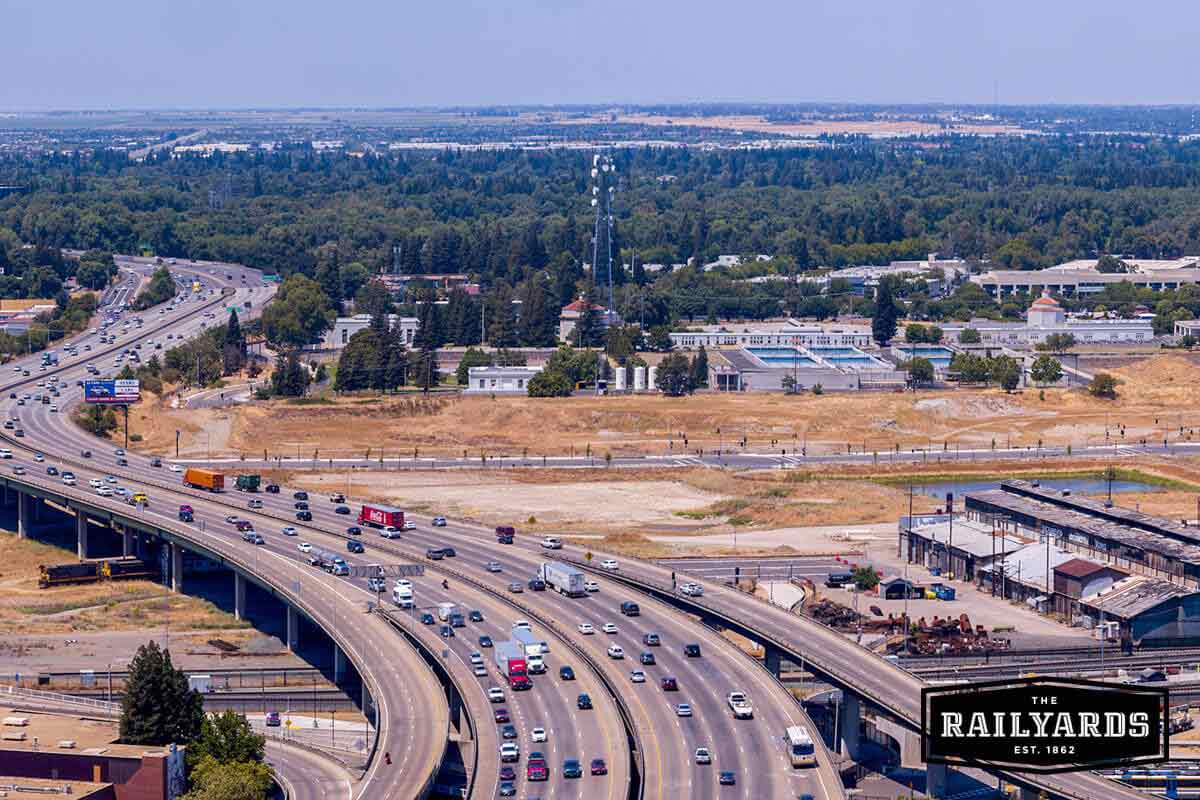
October 26, 2017 / Author: the Railyards
From health care services to computer software to construction, there’s plenty of opportunity in these fastest growing industries in Sacramento.
Sacramento has been a railroad town, a government town, and America’s Farm-to-Fork capital. But what industries and occupations will take over in the future as Sacramento continues to evolve and expand?
We’ve taken a look at the fastest growing jobs in California over the previous five years and compared them to a ten-year national forecast to find the industries poised to surge in Sacramento.
Whether you’re looking for a career change or just getting started down a career path, you may want to consider one of the following:
Health Care
Health care is projected to become the largest major sector in the U.S., according to a ten-year forecast by the Bureau of Labor Statistics (BLS). By 2026, health care and social assistance employment is projected to add nearly 4 million jobs, about one-third of all new jobs.
Five of the ten jobs projected to grow the fastest by percent in the next ten years are in health care and elderly assistance. According to the BLS, these jobs – personal care aides, home health aides, registered nurses, medical assistants, and nursing assistants – will account for almost one-fifth of new net jobs created by 2026.
An aging population is responsible for the booming growth in these occupations. Personal-care aides who perform non-medical duties for older Americans (such as bathing and cooking) and home health aides are projected to create more than 1 million jobs in the next decade.
In California, health care industries and occupations have already demonstrated tremendous growth in the past few years.
From May 2011 to May 2016, medical records and health information technicians jobs have seen a 145.2% growth, while personal and home care aides have seen a remarkable 245.2% growth, according to data from the California Employment Development Department.
The healthcare industry provides approximately 20% of the total payroll for the entirety of Sacramento Region’s workforce; over $18 billion has been spent on new facilities at Kaiser, Mercy, Sutter and UC Davis medical expansion projects in recent years.
Kaiser Permanente is bringing an approximately 1.3 million square foot Medical Center (KP Medical Center) campus to The Railyards development in Sacramento. The KP Medical Center will reside on approximately 18-acres of land in the mixed-use development, and will bring thousands of healthcare jobs to the city.
The KP Medical Center at The Railyards will offer a comprehensive collection of inpatient and outpatient primary and specialty care services; diagnostic and treatment services; surgical services and emergency care; urgent care; radiation/ oncology services; diagnostic services including radiology and telemedicine; women’s services; and supporting ancillary health care services such as optical, pharmacy, laboratory, education and training.
Computers
Computer software engineers and systems software occupations in California have had been growing steadily over the past five years, with a 46.6% increase from 2011 to 2016. The BLS estimates that computer and information technology occupations are projected to grow 13% from 2016 to 2026, faster than the average for all occupations.
These occupations are projected to add about 546,100 new jobs. Demand will stem from greater emphasis on cloud computing, the collection and storage of big data, and information security.
The median annual wage for computer and information technology occupations was $82,860 in May 2016, higher than the median annual wage for all occupations of $37,040. (The median wage is the wage at which half the workers in an occupation earned more than that amount and half earned less.)
Sound appealing?
Many computer occupations require a bachelor’s degree.
Clean Energy
Clean-energy workers, like solar-panel installers and wind-turbine technicians, are the only occupations that are expected to double by 2026. With the City of Sacramento and State of California both putting an emphasis on a sustainable future, it’s no surprise that clean energy jobs will expand in the next decade.
Here’s what you need to know about the fastest growing occupations from 2016 - 2026:
Solar Installers
Solar photovoltaic (PV) installers, also known as PV installers, assemble, install, and maintain solar panel systems on rooftops or other structures.
Employment of solar installers is projected to grow 105% from 2016 to 2026, much faster than the average for all occupations.
- The median annual wage for solar photovoltaic installers in the U.S. was $39,240 in May 2016.
- California is the state with the highest employment level for solar installers, and offers an annual median wage of $45,380.
- The highest 10% earned more than $60,570.
The continued expansion and adoption of solar panel installations will result in excellent job opportunities for qualified individuals, particularly those who complete training courses at a community college or technical school.
Sound interesting?
Although most installers need a high school diploma and typically receive on-the-job training lasting up to 1 year, some candidates take courses at a technical school or community college.
Wind Turbine Service Technicians
Wind turbine service technicians, also known as windtechs, install, maintain, and repair wind turbines
Employment of wind turbine service technicians is projected to grow 96% from 2016 to 2026, much faster than the average for all occupations.
- The median annual wage for wind turbine technicians was $52,260 in May 2016.
- California has the second highest employment level for windtechs (behind Texas), and offers a median wage of $49,080.
- The highest 10% earned more than $76,250.
Because wind electricity generation is expected to grow rapidly over the coming decade, additional technicians will be needed to install and maintain new turbines. Job prospects are expected to be excellent.
Want to get started?
Most windtechs learn their trade by attending technical schools or community colleges, where they typically complete certificates in wind energy technology, although some workers choose to earn an associate’s degree.
What’s Ahead for the Future of Transportation in Sacramento?
Discover the future of transportation in the Sacramento region, and how the City is planning for a green and sustainable future.
Construction
Construction occupations are projected to grow 11% from 2016 to 2026, faster than the average for all occupations. The construction industry is expected to provide a gain of about 758,400 new jobs. Overall economy and population growth increases demands for new buildings, roads, and other structures, which is good news for the construction industry.
In California, construction occupations as a whole have grown by 35.9% in the past five years, but some jobs are far outpacing the industry average.
Drywall and ceiling tile installer jobs in California have grown by 118% from 2011 to 2016. Drywall is the most common interior wall covering in buildings, and demand for these workers comes from new construction of residential and commercial buildings and home-remodeling projects.
Job prospects for drywall and ceiling tile installers is expected to be good because of the need to replace workers who leave the occupation.
- The median annual wage for drywall and ceiling tile installers was $41,090 in May 2016.
- The highest 10% of drywall installers earned more than $79,660.
- The median annual wage for all construction occupations was $43,610 in May 2016, higher than the median annual wage for all occupations of $37,040.
- The median annual wage for construction managers was $89,300.
Sacramento’s Housing Market Paving Way for New Construction Jobs
In 2017, Sacramento was named one of the nation’s hottest real estate markets. According to the Sacramento Association of Realtors, new construction hasn’t kept up with demand, while buyers from the Bay Area are beginning to flood into the region. And Bay Areas transplants aren’t the only reason behind the high-demand for housing.
According to local Sacramento business experts, the “arena effect” has more than met expectations in the downtown core, spurring economic development, stimulating interest from outside investors, and creating a sense of optimism and opportunity throughout the area. A beneficial effect which could multiply after the completion of the MLS stadium in The Railyards.
With all of the high-visibility development projects happening in the Sacramento region, you may think the City couldn’t build any faster. But the supply still hasn’t caught up with demand.
Last year, 7,000 single-family homes were built in the Sacramento region, a 33% increase over 2015, according to figures from the University of the Pacific. In 2017, Sacramento is projected to build 9,600 houses. But that still leaves room for more.
In its Sacramento Region Blueprint, the Sacramento Area Council of Governments says the region needs roughly 12,000 new housing units a year to keep up with population growth.
Many builders would love to do more, but they’re unable to meet the high-demand due to a shortage of skilled construction workers and tradespeople. There’s high demand for skilled workers in the construction industry now and in the next decade.
Want to join this workforce?
Most drywall and ceiling tile installers learn their trade on the job. A formal educational credential is typically not required to enter the occupation.
Construction managers typically must have a bachelor’s degree, and learn management techniques through on-the-job training. Large construction firms increasingly prefer candidates with both construction experience and a bachelor’s degree in a construction-related field.
Mathematicians and Statisticians
Most of the top ten fastest growing occupations are in the health care and personal service industries, but mathematicians and statisticians also appeared on the top-10 list.
In California, computer and mathematical occupations have had a 18% growth over the past five years. Overall employment of mathematicians and statisticians is projected to grow 33% from 2016 to 2026, much faster than the average for all occupations.
Statisticians
Employment of statisticians is projected to grow 33% from 2016 to 2026. This faster-than-average growth is expected to result from more widespread use of statistical analysis to make informed business, healthcare, and policy decisions.
In addition, the large increase in available data from the Internet will open up new areas for analysis.
- The median annual wage for statisticians was $80,500 in May 2016.
- The highest 10% of statisticians earned more than $130,090.
Mathematicians
Employment of mathematicians is projected to grow 29% from 2016 to 2026, much faster than the average for all occupations. The amount of digitally stored data will increase over the next decade as more people and companies conduct business online and use social media, smartphones, and other mobile devices. As a result, businesses will increasingly need mathematicians to analyze the large amount of information and data collected.
Mathematicians will help companies improve their business processes, design and develop new products, and even advertise products to potential customers.
- The median annual wage for mathematicians was $105,810 in May 2016.
- The highest 10% of mathematicians earned more than $160,310.
Sound appealing?
Both mathematicians and statisticians occupations typically require a master’s degree education.
Transportation
Self-driving cars may be coming to Sacramento in the future, but they probably won’t be taking any truck-driving or other transportation jobs away from the labor market in the next ten years. Over the next decade, transportation and material moving occupations are projected to grow 6% from 2016 to 2026, adding 643, 900 new jobs. This growth is about as fast as average for all occupations.
In California, transportation and material moving occupations have grown by 22.1% in the past five years - faster than the national average rate.
The rise of online shopping may be causing the decline of retail jobs, but this change in consumer buying behavior is ensuring that truck drivers still have a career ahead of them, transporting freight and keeping the supply chains moving.
The median annual wage for heavy and tractor-trailer truck drivers was $41,340 in May 2016.
Want to get started?
Heavy and tractor-trailer truck drivers usually have a high school diploma and attend a professional truck driving school and must have a commercial driver’s license (CDL).
From health care services to computer software engineers to construction workers, truck drivers, and statisticians, there’s plenty of opportunity in these fastest growing industries over the next ten years in Sacramento.
Image courtesy of Coruscating Images.











